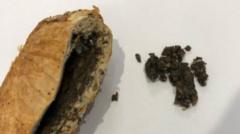**Article Text:**
Australian woman Erin Patterson has been found guilty by a jury for murdering three of her relatives through a toxic beef Wellington meal, as revealed in a gripping trial that has drawn massive attention both nationally and internationally. The 50-year-old, hailing from Morwell in Victoria, was also convicted of the attempted murder of a fourth individual, who survived the perilous meal consumed on July 29, 2023.
The prosecution presented compelling evidence indicating that Patterson deliberately sought out death cap mushrooms from nearby areas, taking steps to disguise her actions by discarding crucial proof and misleading investigators. Tragically, three individuals fell victim to the dish: Patterson's former in-laws, Don and Gail Patterson, both aged 70, as well as Gail’s sister, Heather Wilkinson, aged 66. The only survivor, local pastor Ian Wilkinson, endured a protracted hospital stay following the event.
After the jury delivered their verdict, the Supreme Court of Victoria unveiled a trove of approximately 100 images shared with the jury during the trial. This included photographs of the beef Wellington leftovers that were meticulously collected from Patterson's residence, put into specimen bags to avoid contamination, and sent for toxicological examination.
Death cap mushrooms are notorious for being among the most lethal fungi for humans, responsible for the majority of fatal mushroom poisonings worldwide. Their varied coloration can range from greenish-yellow to brown, tan, or occasionally white, with diameters from 4 to 16 cm (roughly 1.5 to 6 inches).
Patterson asserted that she had bought the mushrooms in dried form from an Asian grocery store in Melbourne but could not recall which specific location. When pressed for documented evidence of this purchase, she claimed the mushrooms were in unmarked packaging and that she likely paid with cash. Nonetheless, investigators unearthed evidence suggesting that death cap mushrooms had recently emerged in two towns near Morwell, leading locals to document their sightings on the iNaturalist online platform, which Patterson had perused.
Further scrutiny of her mobile phone data revealed her visits to locations where the mushrooms were sighted, and she was seen purchasing a food dehydrator along the way back home. Forensic examinations also retrieved images of what appeared to be the mushrooms on her mobile device.
Notably, even minute amounts of death cap mushrooms can result in fatalities, as their poisonous properties remain intact even through cooking or preservation methods.
Additional findings highlighted Patterson's disposal of a food dehydrator the day after she was discharged from the hospital, claiming she had never owned such an appliance. Contradicting this assertion, an instruction manual for the dehydrator was discovered in her kitchen, along with posts on a true crime social media group where she boasted about its use.
Among the released exhibits were still images showing Patterson discarding the dehydrator at a local dumping site just days after the tragic lunch. Two days post-meal, Patterson voluntarily reporting to the hospital for illness without initially agreeing to the treatment for herself and her children, the latter of whom she noted had consumed the leftovers. Remarkably, tests on her children yielded negative results for death cap mushroom poisoning.
The case of the so-called mushroom murders leaves a haunting legacy, as Patterson's actions have been brought to light in an unprecedented public trial marked by poignant moments and dramatic revelations.
Australian woman Erin Patterson has been found guilty by a jury for murdering three of her relatives through a toxic beef Wellington meal, as revealed in a gripping trial that has drawn massive attention both nationally and internationally. The 50-year-old, hailing from Morwell in Victoria, was also convicted of the attempted murder of a fourth individual, who survived the perilous meal consumed on July 29, 2023.
The prosecution presented compelling evidence indicating that Patterson deliberately sought out death cap mushrooms from nearby areas, taking steps to disguise her actions by discarding crucial proof and misleading investigators. Tragically, three individuals fell victim to the dish: Patterson's former in-laws, Don and Gail Patterson, both aged 70, as well as Gail’s sister, Heather Wilkinson, aged 66. The only survivor, local pastor Ian Wilkinson, endured a protracted hospital stay following the event.
After the jury delivered their verdict, the Supreme Court of Victoria unveiled a trove of approximately 100 images shared with the jury during the trial. This included photographs of the beef Wellington leftovers that were meticulously collected from Patterson's residence, put into specimen bags to avoid contamination, and sent for toxicological examination.
Death cap mushrooms are notorious for being among the most lethal fungi for humans, responsible for the majority of fatal mushroom poisonings worldwide. Their varied coloration can range from greenish-yellow to brown, tan, or occasionally white, with diameters from 4 to 16 cm (roughly 1.5 to 6 inches).
Patterson asserted that she had bought the mushrooms in dried form from an Asian grocery store in Melbourne but could not recall which specific location. When pressed for documented evidence of this purchase, she claimed the mushrooms were in unmarked packaging and that she likely paid with cash. Nonetheless, investigators unearthed evidence suggesting that death cap mushrooms had recently emerged in two towns near Morwell, leading locals to document their sightings on the iNaturalist online platform, which Patterson had perused.
Further scrutiny of her mobile phone data revealed her visits to locations where the mushrooms were sighted, and she was seen purchasing a food dehydrator along the way back home. Forensic examinations also retrieved images of what appeared to be the mushrooms on her mobile device.
Notably, even minute amounts of death cap mushrooms can result in fatalities, as their poisonous properties remain intact even through cooking or preservation methods.
Additional findings highlighted Patterson's disposal of a food dehydrator the day after she was discharged from the hospital, claiming she had never owned such an appliance. Contradicting this assertion, an instruction manual for the dehydrator was discovered in her kitchen, along with posts on a true crime social media group where she boasted about its use.
Among the released exhibits were still images showing Patterson discarding the dehydrator at a local dumping site just days after the tragic lunch. Two days post-meal, Patterson voluntarily reporting to the hospital for illness without initially agreeing to the treatment for herself and her children, the latter of whom she noted had consumed the leftovers. Remarkably, tests on her children yielded negative results for death cap mushroom poisoning.
The case of the so-called mushroom murders leaves a haunting legacy, as Patterson's actions have been brought to light in an unprecedented public trial marked by poignant moments and dramatic revelations.



















